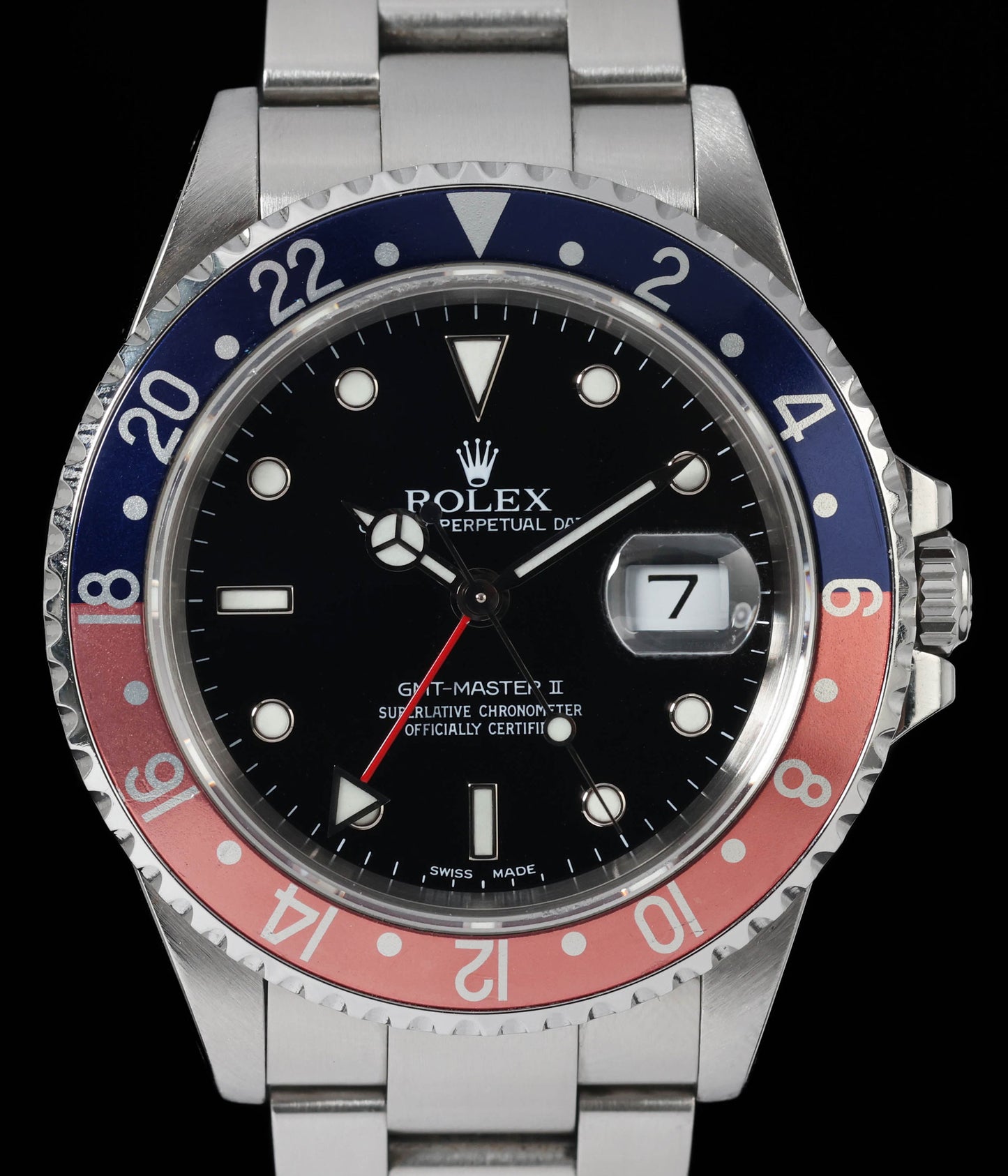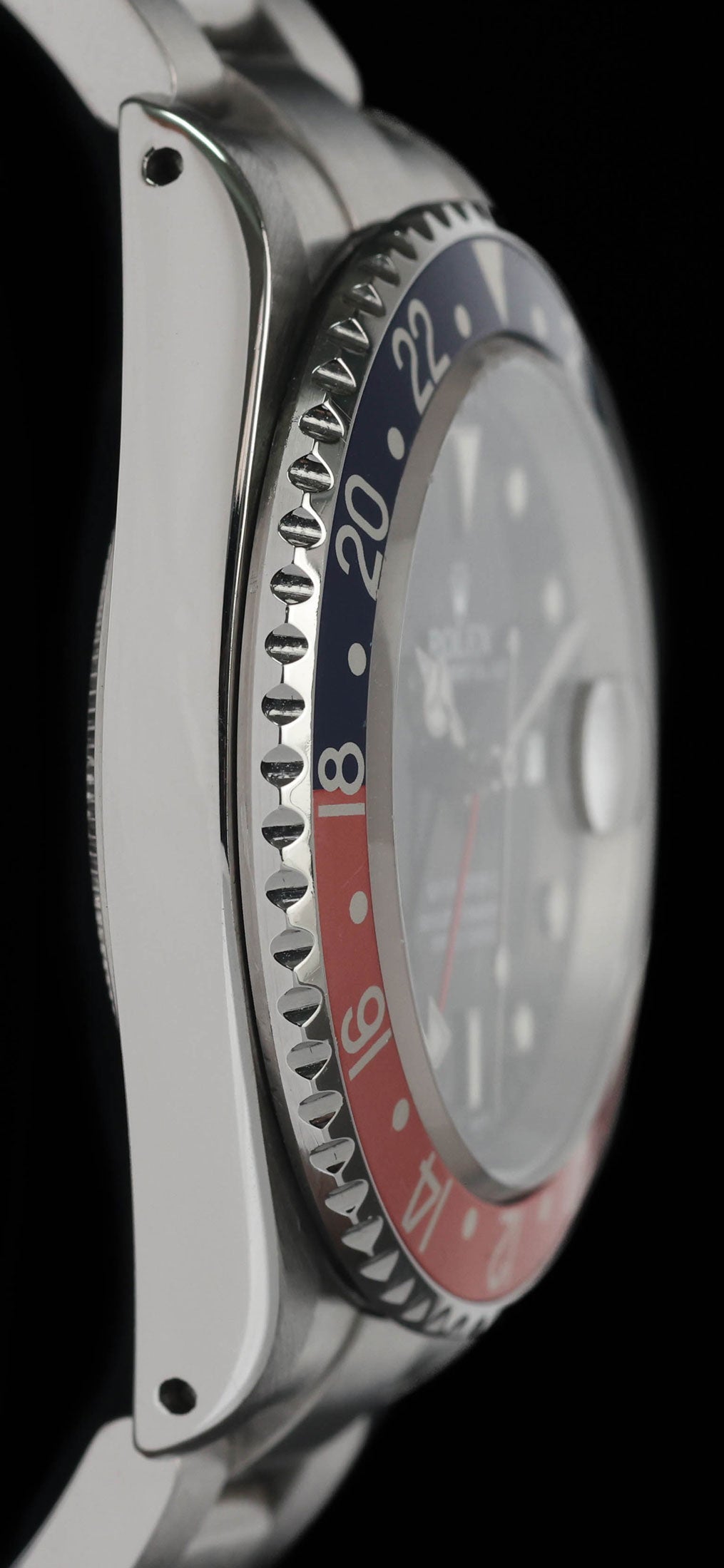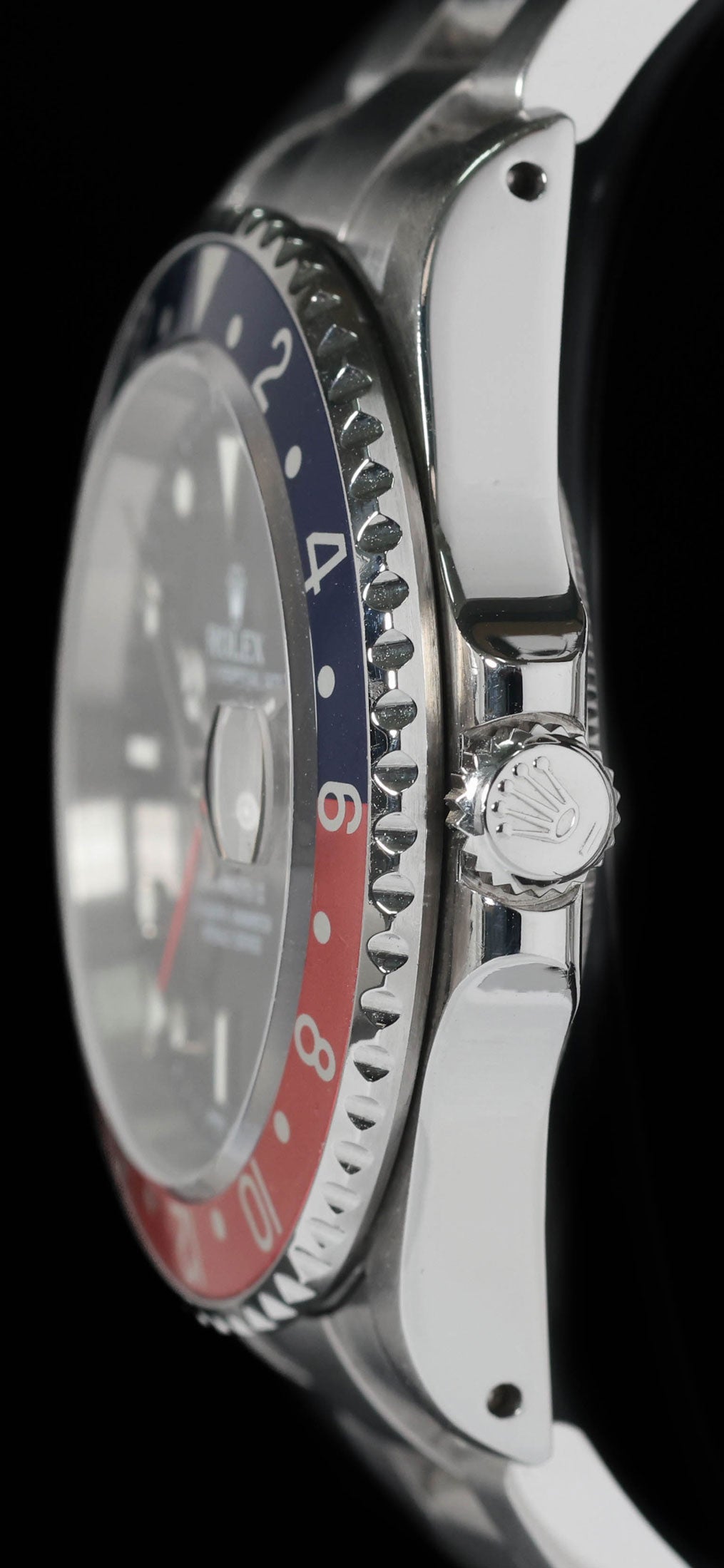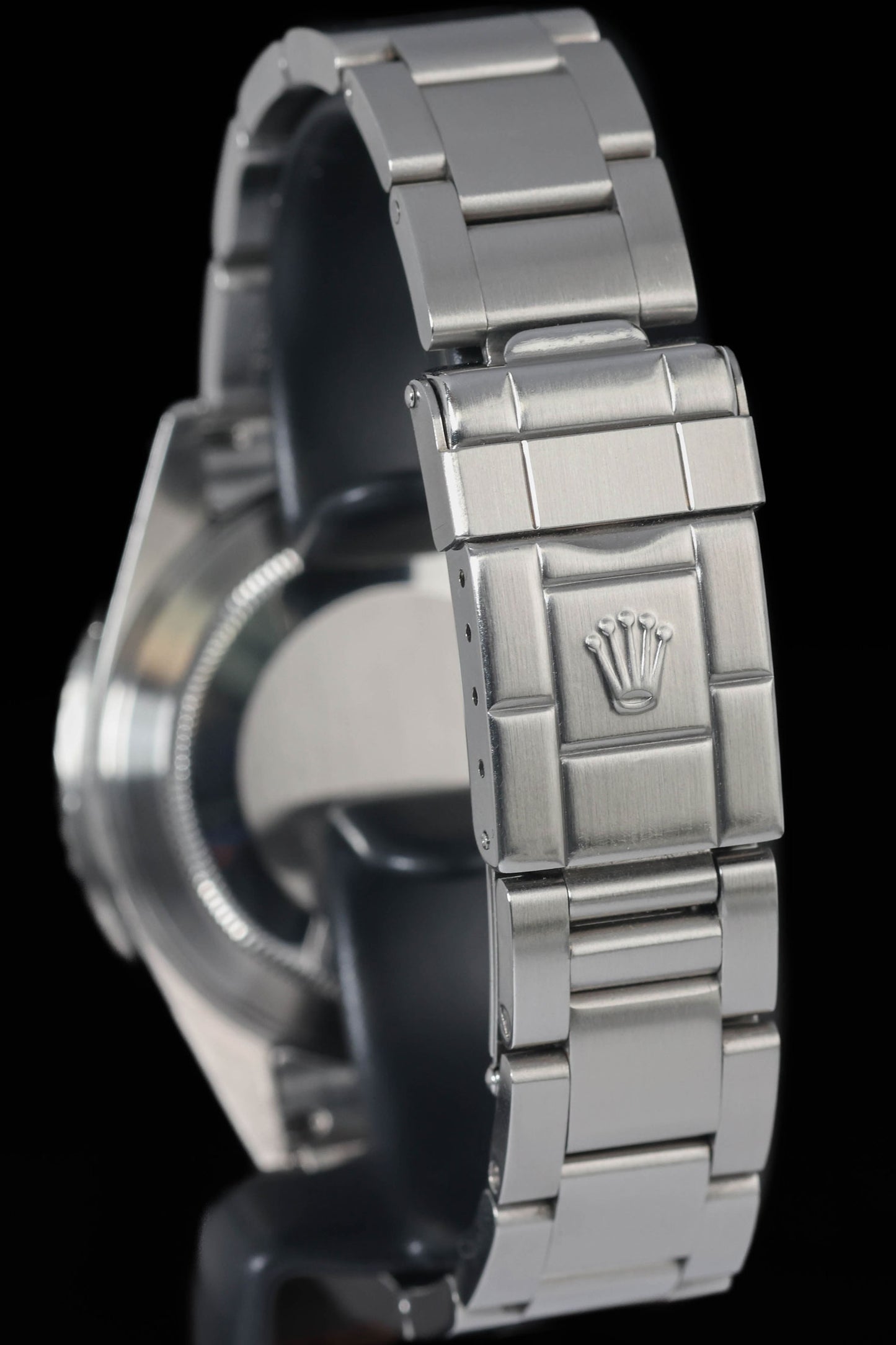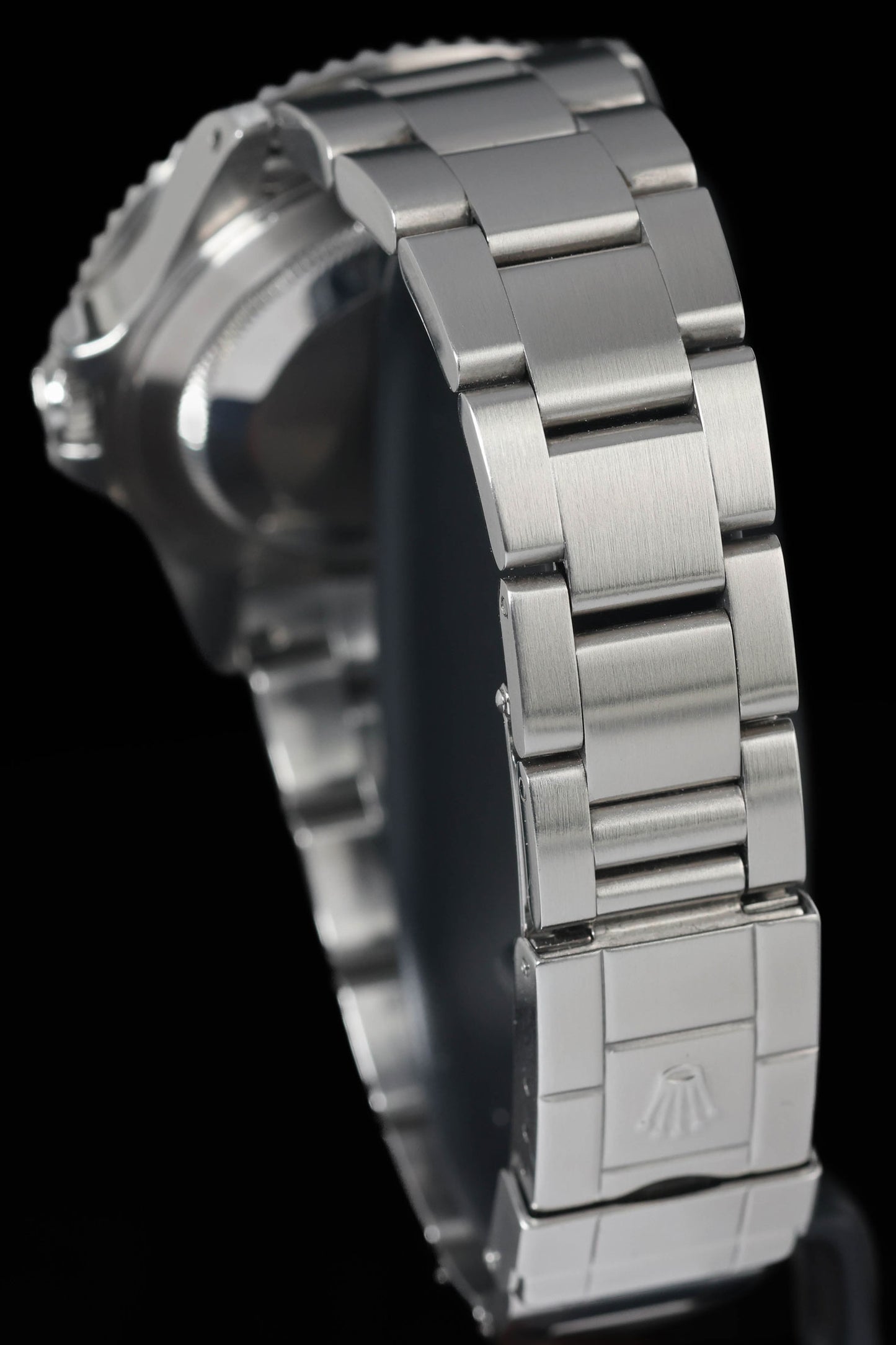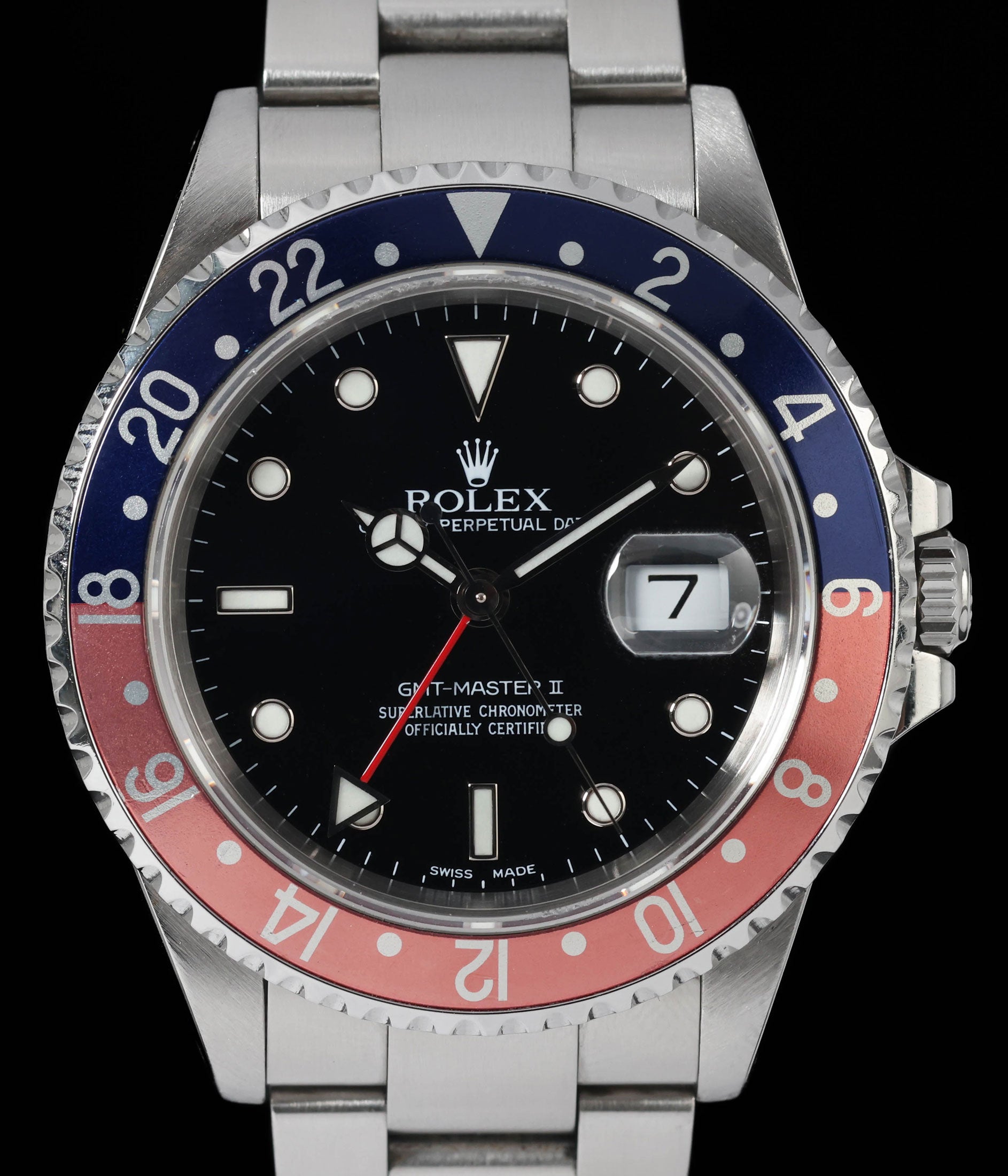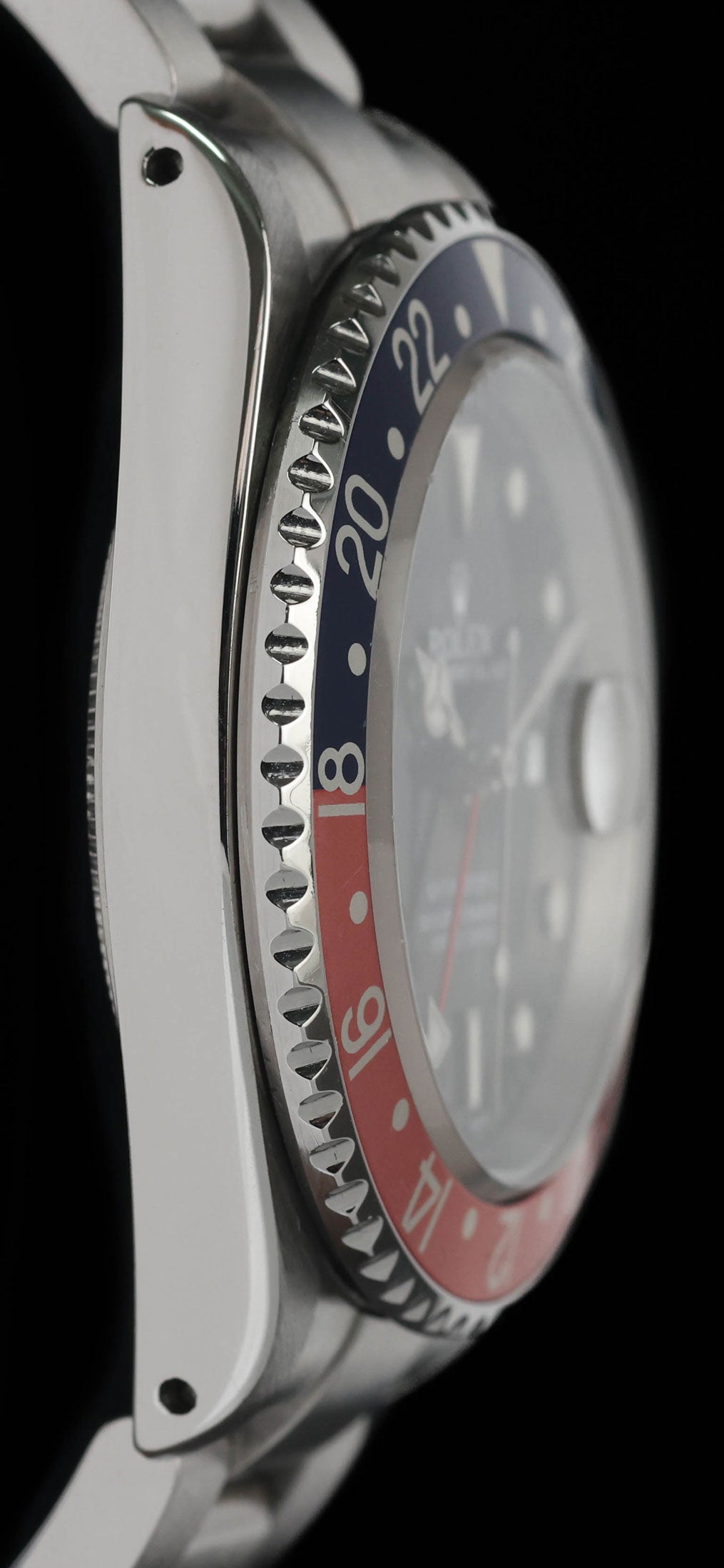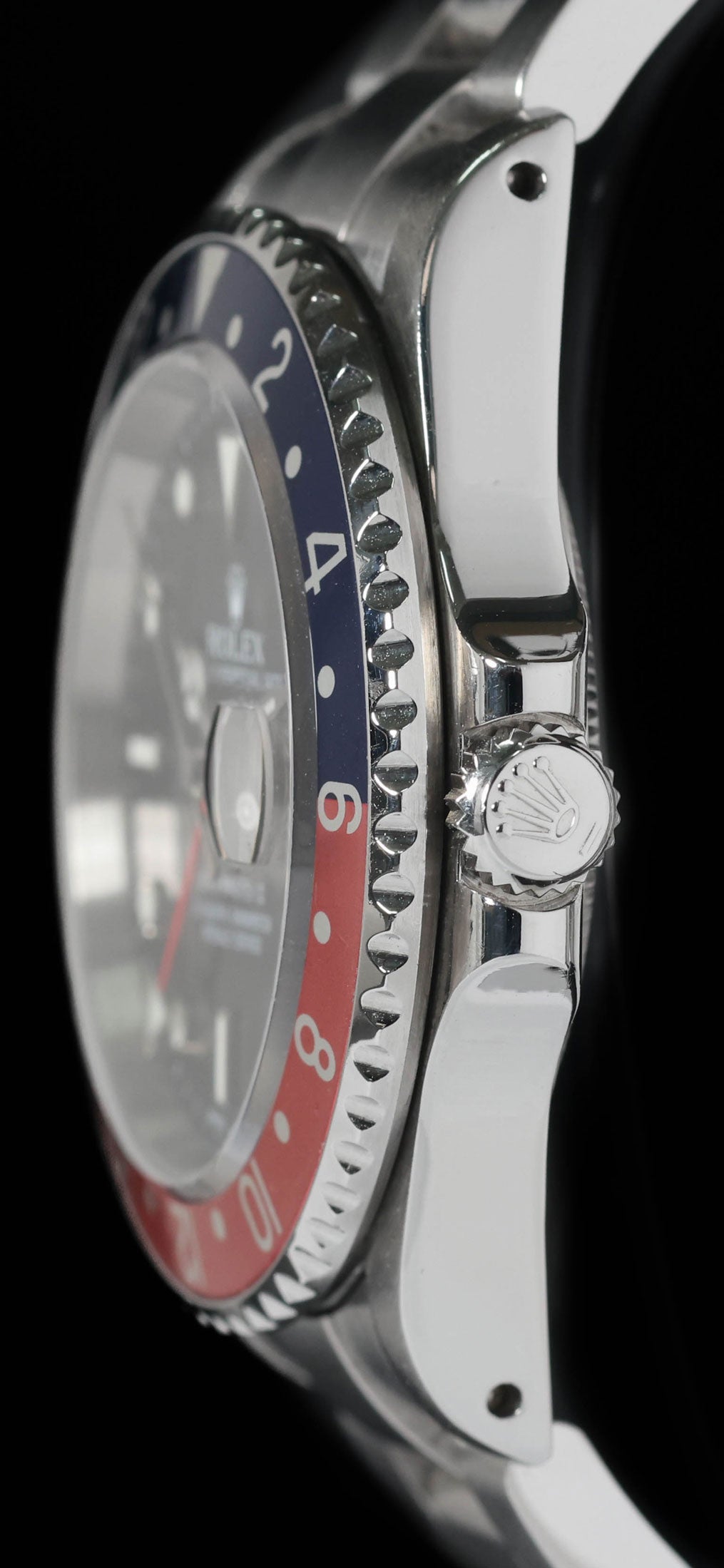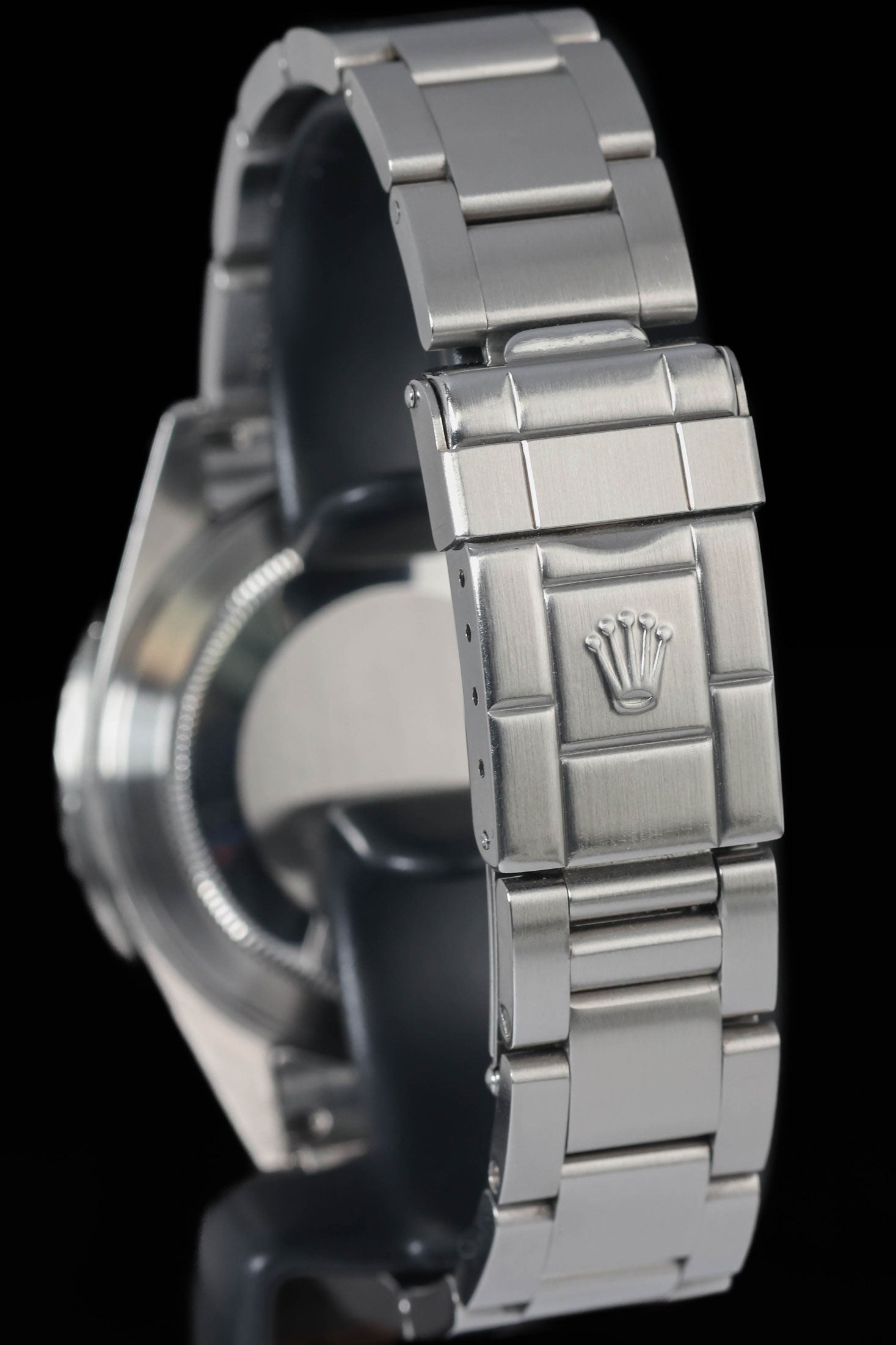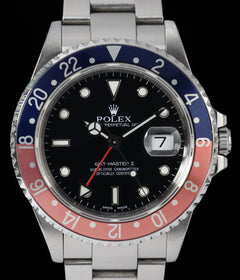Crown Vintage
Rolex GMT Master 'Pepsi' 16710 40mm 2000
Rolex GMT Master 'Pepsi' 16710 40mm 2000
Couldn't load pickup availability
Rolex GMT Master 'Pepsi'
The stainless-steel case presents in excellent overall condition, retaining crisp factory lines and clean brushing with only the lightest handling marks. The matching Oyster bracelet is likewise excellent, showing minimal stretch and tight end links. Its aluminium Pepsi bezel insert has developed an attractive, evenly faded red-and-blue hue that remains legible throughout. Dial and hands are flawless: all printing is sharp, lume plots and handset are intact, and there is no discolouration or corrosion. Sapphire crystal is clear, crown screws down smoothly and all functions operate as intended, reflecting careful use and proper maintenance
Share
Why we love this watch
Why we love this watch
If we were to boil it down to a single word, it would be patina. Just look at that bezel.
Origins and Development
When Rolex updated the GMT-Master line at the end of the 1980s it did so with a watch that looked familiar but behaved very differently under the skin. Reference 16710, launched in 1989, introduced an independently adjustable local-hour hand driven by the new calibre 3185, allowing wearers to step the hour in one-hour jumps without halting the movement—a practical upgrade for airline crews constantly crossing time zones. The model ran in parallel with the slimmer, single-time-zone GMT-Master 16700 until 1999, after which the 16710 became the sole aluminium-bezel GMT in the catalogue. By the year 2000 the reference had entered what many collectors regard as its most balanced phase: it still wore traditional drilled lugs, but Rolex had just upgraded the Oyster bracelet with solid end links for extra rigidity, and the dial had switched from short-lived Luminova to longer-lasting Super-LumiNova, easily spotted by the change from “SWISS” to “SWISS MADE” at six o’clock.
That narrow window—roughly P- and early K-series cases assembled in 2000—captures the end of the classic tool-watch aesthetic before refinements such as laser-etched crystals (introduced 2003) and no-holes cases (late 2003) moved the GMT-Master II slowly toward a more polished, modern identity.
Case and Bezel
Dimensionally the 16710 adheres to the long-standing 40 mm Oyster template yet feels trimmer than its Submariner cousin. Overall thickness is about 12.4 mm, helped by a flatter sapphire crystal and the absence of a diving-style Triplock crown. Drilled lug holes allow for quick strap changes—handy for pilots who preferred leather for long-haul comfort—while solid end-link reference 78790A integrates the bracelet more tightly against the case sides than the earlier hollow 501B links introduced in 1989. Rolex kept water resistance at 100 m, more than adequate for cockpit condensation and occasional poolside wear.
The bezel remains a bidirectional, 120-click construction with an anodised aluminium insert. In the “Pepsi” configuration the upper half glows bright red from 6 to 18 hours, the lower half deep blue, mirroring Pan Am’s corporate colours from the original 1955 GMT-Master commission. The aluminium can scratch and fade—inevitable on a 24-year-old watch—but period “fat-font” inserts from 2000 age to a pleasing cherry-and-navy tone rather than the pastel wash seen on earlier tritium dials. The bezel knurl is shallow yet grippy, making quick time-zone offsets effortless with gloved fingers.
Dial and Hands
Rolex’s dial changes in 2000 were subtle yet significant. After experimenting with single-line “SWISS” Luminova dials in 1998–99, the brand settled on Super-LumiNova for its brighter glow and colour stability, marking the swap with the familiar two-line “SWISS MADE” legend. Hour markers are applied white-gold surrounds filled with the new compound; in most examples they remain crisp and snow-white, a contrast to the vanilla tritium plots that dominate pre-1998 pieces. The handset follows the established Rolex sports pattern: a broad Mercedes hour hand, sword-minute and lollipop seconds, plus the signature red GMT hand tipped with a luminous triangle. Combined with the twenty-four-hour bezel the GMT hand lets travellers read a second time zone at a glance and, by rotating the bezel, a third zone as required.
Font aficionados will notice the slender “II” in GMT-MASTER II and the tight spacing of the “OYSTER PERPETUAL DATE” line—details standardised at the turn of the millennium. The sapphire crystal lacks the later micro-laser coronet, making service-part swaps easier to spot.
Movement
Calibre 3185 drives every 16710 from launch until late 2005, including all year-2000 watches. Built on the proven 3135 base, the 31-jewel automatic beats at 28,800 vph and carries a 50-hour reserve. COSC certification demands −4/+6 seconds per day; most well-serviced examples exceed that in daily wear. The 3185 uses a full balance bridge with a KIF Elastor shock system, micro-stella screws for fine regulation and a free-sprung Breguet overcoil—the architecture that underpins Rolex’s reputation for movement durability.
What sets the 3185 apart is its second wheel set riding on the motion works, decoupled from the gear train when the user pulls the crown to the second position. One direction jumps the local-hour hand in discrete one-hour clicks forward or back, simultaneously advancing or reversing the date wheel; the other direction adjusts the “home” 24-hour hand synchronised to the seconds, bridging the gap between traditional GMTs and the ubiquitous quick-set date sports watch. Although late-2007 pieces moved to the 3186 with a revised balance support and different wheel height, collectors consider the 3185 the purist’s choice: thin, reliable and intimately linked to the original design brief.
Market Reception and Legacy
At launch the 16710 retailed in Australia for around A$5,900, positioning it well below gold Submariners yet slightly above the Explorer II. Demand spiked after 1990 when American Airlines and Qantas uniform codes loosened, allowing cockpit staff to wear personal wristwatches; flight crews appreciated the independent hour-hand adjustment and lighter profile relative to the so-called “Fat Lady” 16760 of 1983. By 2000 production was hitting its stride, and the Pepsi insert commanded roughly the same price as the “Coke” red-black or all-black versions, reflecting equal parts brand heritage and personal preference.
Today Chrono24 lists year-2000 Pepsi 16710s between A$17,000 and A$23,000 depending on service history, bezel condition and bracelet correctness. Pieces retaining their original “Swiss Made” dial, drilled-lug case and solid end-link bracelet rank as a sweet spot: modern enough for daily wear, vintage enough to pre-date laser coronets and chunky re-designs. The reference also stands as the last aluminium-insert Pepsi prior to Rolex’s 2007 move to Cerachrom, making it the final expression of the classic red-and-blue look that many enthusiasts still associate with the Jet Age.
Beyond pricing, the 16710’s legacy lies in its balance: a versatile travel watch equally at home under a suit cuff or strapped over a bomber jacket, free of the maxi indexes and broad-lug heft introduced on the six-digit GMT-Master II from 2007 onward. Its case proportions echo mid-1980s Submariners, its bezel action feels tactile in a way ceramic cannot match, and the independent hour hand remains as intuitive today as it was revolutionary forty years ago.
Final thoughts
The Rolex GMT-Master II Pepsi 16710 from 2000 captures a pivotal moment in the model’s evolution. It marries traditional tool-watch cues—drilled lugs, aluminium bezel, slimmer 40 mm case—with incremental technical improvements like solid end links and Super-LumiNova, all powered by the workhorse calibre 3185. For collectors and frequent travellers alike it represents the last chapter before Rolex shifted the GMT line toward luxury presentation and ceramic technology. Slim on the wrist, mechanically practical and instantly recognisable in its red-and-blue livery, the year-2000 16710 remains a compelling reference that bridges vintage charm and modern reliability in equal measure.
Case & Bracelet
Case & Bracelet
Case and bracelet in excellent condition. Evenly faded Pepsi bezel.
Dial & Hands
Dial & Hands
Dial and hands are flawless.
Warranty & Condition
Warranty & Condition
Crown Vintage Watches provides a minimum 3-month mechanical warranty on pre-owned watches, from the date of purchase.
The warranty covers mechanical defects only.
The warranty does not cover damages such as scratches, finish, crystals, glass, straps (leather, fabric or rubber damage due to wear and tear), damage resulting from wear under conditions exceeding the watch manufacturer’s water resistance limitations, and damage due to physical and or accidental abuse.
Please note, water resistance is neither tested nor guaranteed.
Shipping and insurance costs for warranty returns to us must be covered by the customer. Returns must be shipped via traceable courier. Return shipment must be pre-paid and fully insured. Collect shipping will be refused. In case of loss or damages, the customer is liable.
Our Pledge
At Crown Vintage Watches, we stand by the authenticity of every product we sell. For added peace of mind, customers are welcome to have items independently authenticated at their own expense.
Condition
Due to the nature of vintage timepieces, all watches are sold as is. We will accurately describe the current condition and working order of all watches we sell to the best of our ability.
Shipping & Refund
Shipping & Refund
